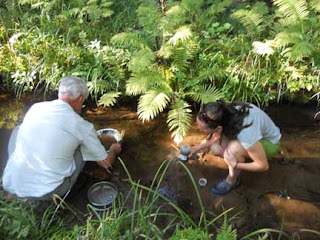By Michele Bourdieu
At the May 5, 2012, Presidential Caucus in Houghton, Scott Dianda tells Democrats why he is running for the Michigan 110th District Representative seat next November -- education, jobs and local control of government. (Photos by Keweenaw Now)
Residents register before voting in the Houghton County May 5 presidential caucus, held in the Super 8 Motel in Houghton. Pictured, clockwise from left, are volunteers Joan Antila and Barbara Manninen and (registering) June Michaelson and Elise Matz.
"Let's get President Obama elected, let's take back Congress and let's take back the State of Michigan," Dianda said to voters at the caucus.
Dianda will run next November against his 2010 opponent for this seat, Rep. Matt Huuki (R) of Atlantic Mine.
Houghton County Democratic Party Vice-Chair Brian Rendel (standing, right) welcomes voters to the caucus and invites them to join the Houghton County Dems at their Spring Fling annual awards dinner and fundraiser to be held this Saturday, May 12, at the Bluffs in Houghton.*
Preceding the caucus vote, Houghton County Democratic Party member Rick Kasprzak, right, reads some messages from Democratic candidates in Michigan, including Gary McDowell of Rudyard, who is running for the First District U.S. Congressional seat now held by Republican Dan Benishek. In his message, McDowell said, "I'm running for Congress because no one else is looking out for the people of the UP."
At the May 5, 2012, Democratic Presidential Caucus, voters hold up cards for a show-of-hands vote for President Barack Obama as the Democratic Nominee for President in 2012. The vote of more than 40 persons was unanimous.
Janet Gregorich, Houghton County Democratic Party vice-chair, was happy with the turnout at the caucus.
"I think the turnout was great since there was really no opposition for our presidential candidate," Gregorich said. "We're all for Obama and we're united and we'll work to get all of our Democrats elected."
Ann Pace of Hancock added, "As always, engagement in the political process is energizing."
That energy was evident in the crowd that gathered near the Portage Lift Bridge for a Labor Rally to celebrate workers' rights and cheer for Dianda as he kicked off his campaign.
Terry LaJeunesse, retired teacher and Michigan Education Association (MEA) representative and a member of the Western Upper Peninsula Community Action Team that led the rally, spoke about a petition drive to place on the November ballot a proposal for a Michigan constitutional amendment that guarantees all workers the right to collective bargaining.
Terry LaJeunesse, retired teacher and MEA representative, speaks at the Labor Rally near the Portage Lift Bridge on May 5, 2012. (Video clips by Allan Baker for Keweenaw Now)
Scott Dianda addresses the crowd at the Labor Rally and asks for their support of his candidacy for Michigan's 110th State Representative seat.
Rally participants, many carrying signs, march across the Lift Bridge to Hancock.
More photos ...
Return to Houghton ...
At Veterans' Park ...
After the Rally, the Houghton County Democratic Party sponsored a taco social at the Super 8.
* The Houghton County Democrats' Spring Fling silent auction begins at 5:30 p.m., dinner at 6:30 p.m. and program at 7 p.m. this Saturday, May 12. Click here for tickets.





























































































































































